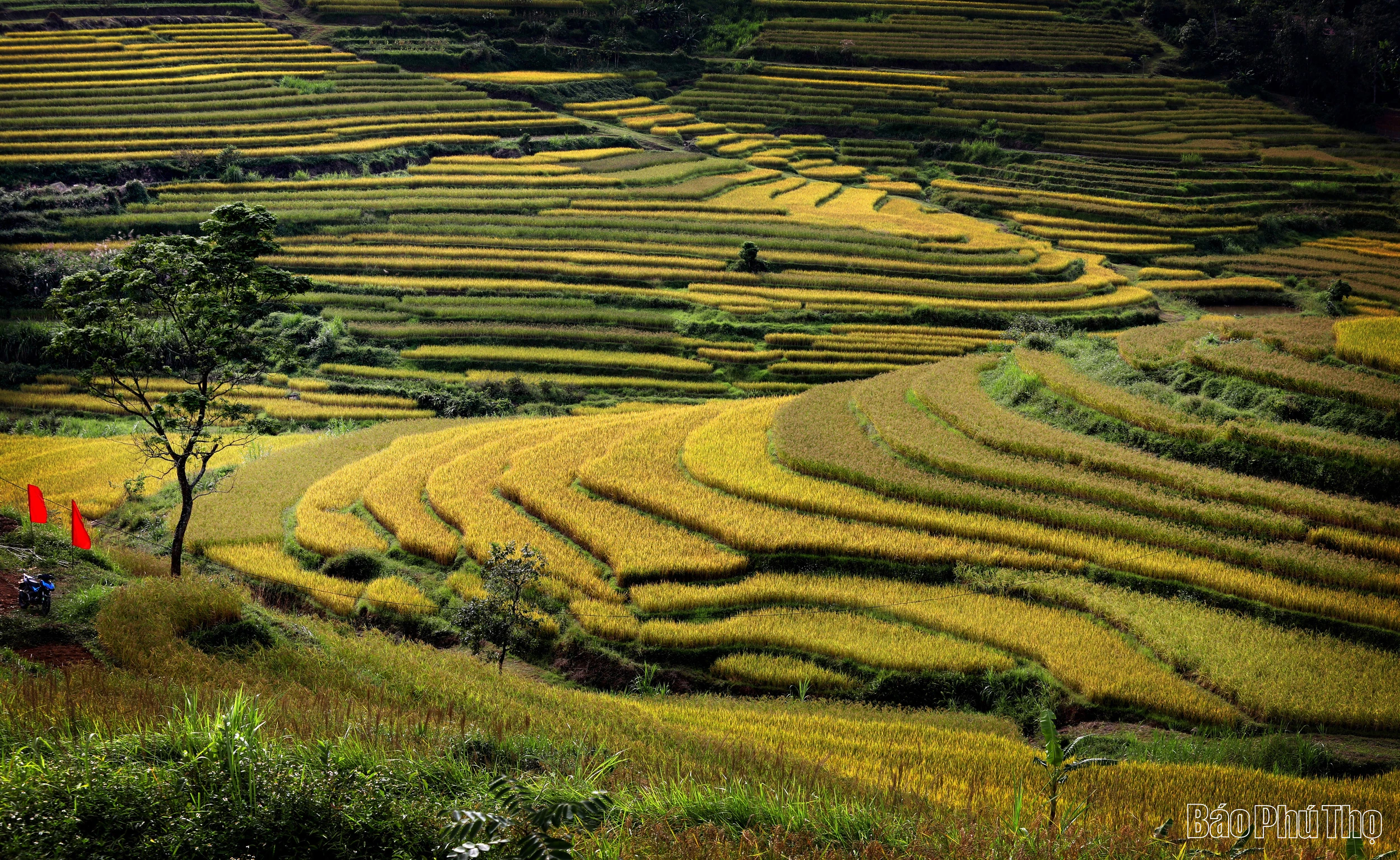{title}
{publish}
{head}
The road leading me to Muong Vang (formerly comprising Quy Hoa, Tuan Dao, and Tan Lap communes) winds through endless rice fields that embrace the Tan Lap valley. The Muong people say that here, they not only “eat rice” but also “worship it,” honoring each grain as part of their soul.

This story begins in Da Trai Cave, in the former Tan Lap commune. In 1982, archaeologists discovered fossilized rice grains in the cave, evidence that the Muong people have cultivated wet rice for thousands of years. It’s no coincidence that the rice of Muong Vang is renowned for its soft texture and fragrant aroma. It is the crystallization of nature and generations of skilled hands. Standing at the cave’s entrance, as the valley wind carries the scent of ripening rice mingled with the earthy aroma, I suddenly understand: here, a grain of rice is not merely food—it is memory, cultural identity.
Today, Muong Vang has moved beyond just two rice crops a year. Since 1987, new rice varieties like Khang Dan, AT77, and Nep 352 have been introduced, boosting yields and bringing annual cultivated areas to thousands of hectares. Mechanization has arrived in the fields. Locals now plant winter corn on two-crop land, with yields exceeding 4.5 tons per hectare. Water-scarce fields are converted to grow vegetables, mulberries, and fruit trees, generating stable incomes.
Leaving Tan Lap, I headed to Mien Doi commune (now Thuong Coc), where the traditional Nep Trung Khe rice variety—known in Muong language as Trung khe—is still preserved.
The Muong treasure this sticky rice so much that it’s used as a ceremonial offering in weddings and festivals.
This variety thrives best in Mien Doi’s terraced fields, where the cool water sources and mineral-rich highland soil create the perfect environment. Trung Khe rice is highly nutritious, with short, round grains that cook up soft, fragrant, and slightly sweet—fetching prices far higher than ordinary rice.
In early 2023, Mien Doi launched an OCOP product for Trung Khe rice. The Mien Doi Agricultural and General Services Cooperative took the lead, providing technical training and guiding farmers in organic cultivation to ensure quality. By the end of the year, “Trung Khe Sticky Rice” was officially recognized as a 3-star OCOP product—a source of pride for the Muong region. In 2024, the cultivation area expanded to 18 hectares with 130 participating households, aiming for commercial production tied to experiential tourism and export.
But beyond abundant harvests, Muong Vang and Thuong Coc are crafting a new story—preserving indigenous rice varieties as a pathway to sustainable economic growth.
Mr. Bui Van Cuong, Vice Chairman of the Thuong Coc Commune People’s Committee, emphasized: “Trung Khe Sticky Rice is a treasure. We’re not just preserving it—we’re elevating its OCOP brand, developing organic products, and promoting experiential tourism.”
Meanwhile, leaders in Muong Vang stated: “Rice remains our backbone, but it must be cultivated differently—with safe, organic practices that increase value rather than just yield. The commune encourages expansion of high-quality varieties, mechanization, and enterprise partnerships to give Muong Vang rice a firm market standing.”
Hong Duyen

baophutho.vn Hoa Binh Lake is among the largest hydropower reservoirs in northern Vietnam, offering significant potential for tourism development and...

baophutho.vn Van Son Commune, known as the “Roof of the Muong Region” — or affectionately called “Cloud Valley” — sits at an altitude of around 1,000 meters...

baophutho.vn Con Pass — a long, winding and perilous mountain pass that links the center of Thu Cuc Commune (Phu Tho Province) with Nga Hai on the far side...

baophutho.vn Nestled peacefully along the Red River, Van Ha carpentry village (formerly in Ly Nhan Commune, Vinh Tuong District, Vinh Phuc Province), now...

baophutho.vn Located in the majestic Northwest region of Phu Tho Province, Tan Mai Commune resembles a picturesque harmony of mountains and rivers. Blessed...

baophutho.vn Dan Tru Hamlet, Tam Hong Commune, Phu Tho Province is renowned for Tro Pagoda – Dai Phuc Tu, one of the region’s long-standing spiritual...

baophutho.vn From a land blessed with poetic landscapes—where the Da River reservoir meets the distinct Muong cultural identity—Thung Nai Commune is...

baophutho.vn Nestled in the lush green valley of Thung Nai Commune, Mo Hamlet appears like a rustic painting, where traditional stilt houses rest beside...

baophutho.vn The vibrant colors of Pa Co Market, located in Pa Co Commune, are woven together from the radiant beauty of brocade fabric, the bright smiles...

baophutho.vn After the administrative merger, Phu Tho Province has entered a new development phase with great potential in culture and tourism. The province...